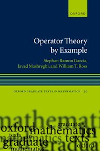- About MAA
- Membership
- MAA Publications
- Periodicals
- Blogs
- MAA Book Series
- MAA Press (an imprint of the AMS)
- MAA Notes
- MAA Reviews
- Mathematical Communication
- Information for Libraries
- Author Resources
- Advertise with MAA
- Meetings
- Competitions
- Programs
- Communities
- MAA Sections
- SIGMAA
- MAA Connect
- Students
- MAA Awards
- Awards Booklets
- Writing Awards
- Teaching Awards
- Service Awards
- Research Awards
- Lecture Awards
- Putnam Competition Individual and Team Winners
- D. E. Shaw Group AMC 8 Awards & Certificates
- Maryam Mirzakhani AMC 10 A Awards & Certificates
- Two Sigma AMC 10 B Awards & Certificates
- Jane Street AMC 12 A Awards & Certificates
- Akamai AMC 12 B Awards & Certificates
- High School Teachers
- News
You are here
Operator Theory by Example

Publisher:
Oxford University Press
Publication Date:
2023
Number of Pages:
528
Format:
Paperback
Series:
Oxford Graduate Texts in Mathematics
Price:
115.00
ISBN:
978-0192863874
Category:
Textbook
[Reviewed by , on ]
Frederic Morneau-Guérin
10/8/2023
When it comes to teaching mathematics, it quickly becomes apparent that pedagogical and didactic interests are never perfectly aligned. The quality of a textbook therefore depends on how well the authors manage to reconcile these conflicting interests. In this respect, we must admit that the authors of Operator Theory by Example, Stephan Ramon Garcia, Javad Mashreghi and William T. Ross, have managed to find the ideal balance.
As the title suggests, this book places a strong emphasis on instructive examples. Moreover, it is important to specify that this book is less focused on concepts than on specific operators such as the unilateral and bilateral shift operators, Cesàro operators, Volterra operator, Bishop operator, Toeplitz and Hankel operators, or Dirichlet and Bergman shift operators. In other words, the theory of operators is developed in conjunction with the study of concrete properties (norm, spectrum, compactness, invariant subspaces, etc.) of the operators under consideration, rather than in the abstract.
Although this is not reflected in the title, this book deals specifically with bounded operators defined on Hilbert spaces. This means that neither operators on Banach spaces nor operator algebras are discussed (beyond what is strictly necessary to ensure overall coherence and a measure of completeness), nor are unbounded operators on Hilbert spaces. This bold choice can be explained by the fact that the authors wished to devote a large proportion of the book to the study of non-normal operators, which are not covered in many of the classic reference books.
Although any young researcher can certainly benefit from reading this book, which is not intended to be a comprehensive treatise on the theory of operators; its target audience is graduate students in mathematics. Moreover, in order to reach as broad an audience as possible, the authors have tried to reduce the essential prerequisites to a bare minimum. Anyone familiar with the rudiments of integration in the Lebesgue sense and the standard content of an introductory undergraduate course in complex analysis will be able to move effortlessly from cover to cover.
In terms of style, without patronizing their readers, the authors not only highlight the key ideas in the arguments and evidence presented, but also make the effort to offer detailed explanations for some subtle points that are often glossed over in other works of the same type. The authors' concern with pedagogy also manifests itself in a variety of other ways, such as the occasional use of different shades of grey in the text and colour in the figures to draw attention to important details; the frequent use of infinite matrix representations of operators to better 'see' their structure and effect; and a polished, airy and aesthetically impeccable presentation that facilitates both reading and understanding.
While the main body of the text is organised in the usual way (a foreword followed by a brief overview of the general concepts of operator theory, and then 20 chapters totalling more than 450 pages), the structure of the chapters is somewhat original. A list of key concepts is given at the outset. This is followed by a one-paragraph chapter summary. Next is the body of the text, and then a short section in which a historical overview of the development of the ideas mentioned above is provided. This last section includes references to primary sources as well as to sources of interest to anyone wishing to delve deeper into a particular subject. Finally, the chapters close with a list of exercises followed by a few focused tips.
One of the distinguishing features of this book is undoubtedly the abundance of exercises it contains. There are more than 600 of them, spread fairly evenly across the 20 chapters. Varying in difficulty, the problems range from simple exercises to consolidate newly acquired knowledge to demonstration of a technical detail that has been skimmed over in the main text. There are also a few multifaceted problems where elements are covered (such as Hilbert-Schmidt operators or trace operators) that could have been the subject of an entire section but, for lack of space, have been relegated to the background.
The book is well equipped with additional tools to make it easier to find information. The introductory pages contain an index of symbols and notations used throughout the text, accompanied by a short written description and a page number for reference. An index by author and an index by subject are presented at the very end of the book. Finally, with a Reference section containing 380 titles (ranging from fundamental 200-year-old texts to research articles dating from the 2020s), this is a thoroughly researched work.
Frederic Morneau-Guerin is a professor in the Department of Education at Universite TELUQ. He holds a Ph.D. in abstract harmonic analysis.
See the publisher's website.
- Log in to post comments




